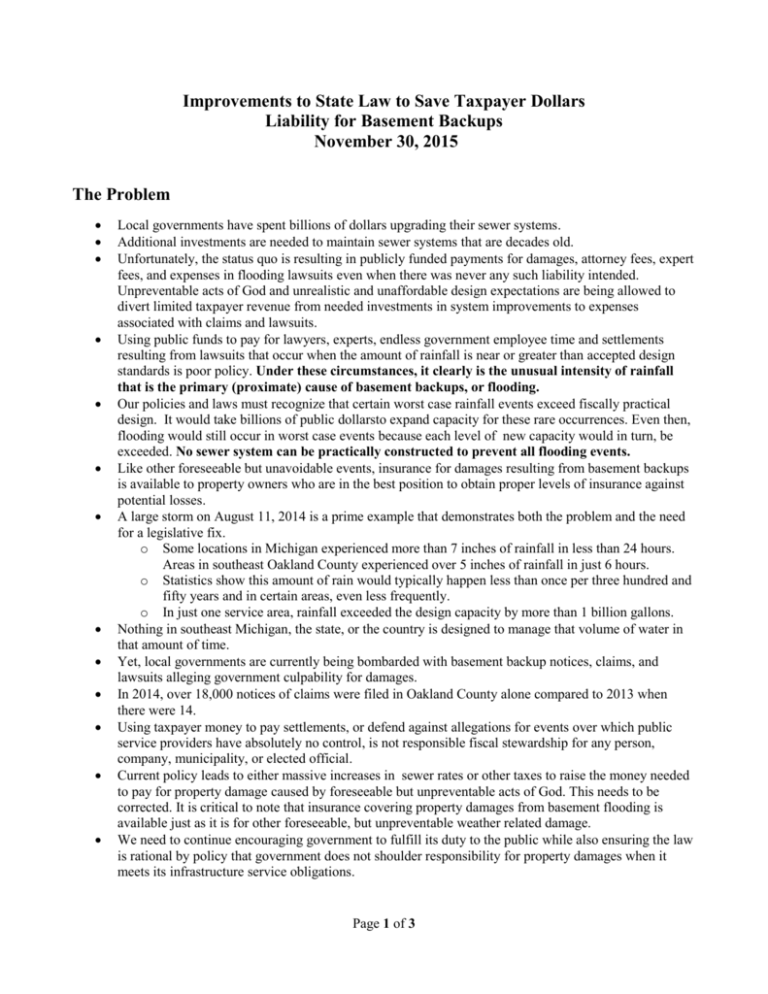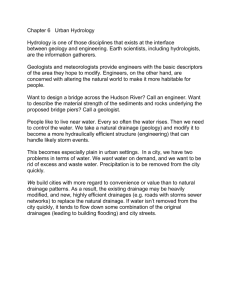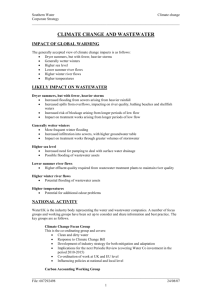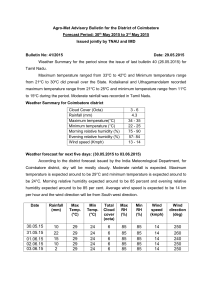Information Highlights on PA 222
advertisement

Improvements to State Law to Save Taxpayer Dollars Liability for Basement Backups November 30, 2015 The Problem Local governments have spent billions of dollars upgrading their sewer systems. Additional investments are needed to maintain sewer systems that are decades old. Unfortunately, the status quo is resulting in publicly funded payments for damages, attorney fees, expert fees, and expenses in flooding lawsuits even when there was never any such liability intended. Unpreventable acts of God and unrealistic and unaffordable design expectations are being allowed to divert limited taxpayer revenue from needed investments in system improvements to expenses associated with claims and lawsuits. Using public funds to pay for lawyers, experts, endless government employee time and settlements resulting from lawsuits that occur when the amount of rainfall is near or greater than accepted design standards is poor policy. Under these circumstances, it clearly is the unusual intensity of rainfall that is the primary (proximate) cause of basement backups, or flooding. Our policies and laws must recognize that certain worst case rainfall events exceed fiscally practical design. It would take billions of public dollarsto expand capacity for these rare occurrences. Even then, flooding would still occur in worst case events because each level of new capacity would in turn, be exceeded. No sewer system can be practically constructed to prevent all flooding events. Like other foreseeable but unavoidable events, insurance for damages resulting from basement backups is available to property owners who are in the best position to obtain proper levels of insurance against potential losses. A large storm on August 11, 2014 is a prime example that demonstrates both the problem and the need for a legislative fix. o Some locations in Michigan experienced more than 7 inches of rainfall in less than 24 hours. Areas in southeast Oakland County experienced over 5 inches of rainfall in just 6 hours. o Statistics show this amount of rain would typically happen less than once per three hundred and fifty years and in certain areas, even less frequently. o In just one service area, rainfall exceeded the design capacity by more than 1 billion gallons. Nothing in southeast Michigan, the state, or the country is designed to manage that volume of water in that amount of time. Yet, local governments are currently being bombarded with basement backup notices, claims, and lawsuits alleging government culpability for damages. In 2014, over 18,000 notices of claims were filed in Oakland County alone compared to 2013 when there were 14. Using taxpayer money to pay settlements, or defend against allegations for events over which public service providers have absolutely no control, is not responsible fiscal stewardship for any person, company, municipality, or elected official. Current policy leads to either massive increases in sewer rates or other taxes to raise the money needed to pay for property damage caused by foreseeable but unpreventable acts of God. This needs to be corrected. It is critical to note that insurance covering property damages from basement flooding is available just as it is for other foreseeable, but unpreventable weather related damage. We need to continue encouraging government to fulfill its duty to the public while also ensuring the law is rational by policy that government does not shoulder responsibility for property damages when it meets its infrastructure service obligations. Page 1 of 3 Local Government Immunity and Liability in Michigan Governmental entities are immune to tort liability unless the legislature creates an exception. Until 2001, there were only a few exceptions such as highways, public buildings and motor vehicles. The Michigan Supreme Court clarified that no liability existed for government related to sewer backups in 2001. That same year, an exception for basement backups was created by the legislature in 2001 PA 222. This policy shift resulted from the recommendations of a legislative workgroup focusing on sewage disposal systems. This new policy established that local governments do not have absolute immunity. However, the new exception to immunity was carefully limited to specific circumstances, most notably, only when the evidence points to a defect that is at least 50% or more responsible for damages. The Solution Michigan law (2002 PA 222 ) creating the limited exception to immunity was founded on four principles: Facilitating Accountability: By limiting liability to instances where the government was 50% or more responsible for the backup Providing Certainty: So that service providers know what they must do to meet their responsibilities Recognition: That preventing all flooding is not feasible Increasing Public Protection: So that taxpayers and businesses do not bear the cost of unnecessary litigation and by increasing the awareness of the availability of private insurance coverage Lessons learned since 2002 result in an opportunity to further advance these same principles for the public interest. Three statutory amendments are proposed to save taxpayer and ratepayer money and provide further protection for homeowners and businesses. They are listed below in order of priority. 1. Explicitly Establish that Immunity Continues to Apply when Rainfall is so Intense it is Clearly the Main Cause of a Backup On August 11, 2014, an extraordinary amount of rain fell in a matter of hours. No sewer system is capable of handling the volume of water from such an intense storm. When these intense rainfall events do occur, it is clearly the amount of rainfall that is the proximate cause (50% or more) of any backup or flooding. Yet, thousands of claims (many that have developed into class action lawsuits) are being filed with government agencies alleging that government is responsible for damages from this unpreventable event. This is akin to making government liable for individual motorist losttime resulting from hours of traffic gridlock caused by an unusually severe car crash. Language is proposed clarifying there is no exception to immunity when and where this intense, unpreventable rainfall occurs. 2. Improve Certainty by Elaborating on Service Provider Responsibility PA 222 appropriately provided an exception to immunity for construction and design defects if they are a 50% or greater proximate cause of the flooding. This was designed to provide certainty so that service providers know what they must do to meet their responsibilities. This also was designed to provide certainty to the public so they know that the applicable standards are specific to that time and location, not to standards for systems constructed later, in other places. Periodically, the state orders improvements to sewer systems that result in modifications to original construction and design. This is not done across the board, but on a case by case basis. The law can be improved so that it is clearer that the appropriate governmental agency is accountable for the requirements applicable to its service provision and that includes ordered system changes. Page 2 of 3 Language is proposed to make clearer that exceptions to immunity resulting from alleged construction and design defects are to be based on applicable requirements in the area and at the time of design or construction and this includes state required modifications, if any. 3. Make Notice Provisions Clearer to the Public Current law describes a specific process for filing claims and for governmental agencies to follow so the public is informed. However, the language creates some ambiguity which could unintentionally penalize claimants for not sending their notice to assert a claim to the correct governmental contacts or the correct governmental agencies. This confusion has already led to adverse Michigan Court of Appeals decisions. Further, like other Governmental Tort Liability Act exceptions to immunity, a claimant must give separate notice to each agency they intend to file a lawsuit against. Language is proposed requiring the designation of a specific point of contact by a responsible government agency and clarifying that a claim or notice of intent to sue must be sent to each governmental agency the claimant intends to sue. This will help ensure the public knows who to notify. Page 3 of 3









